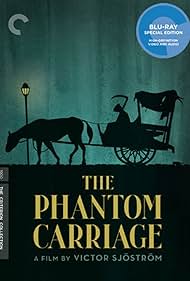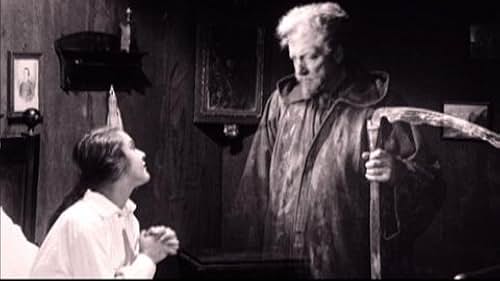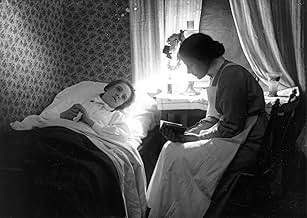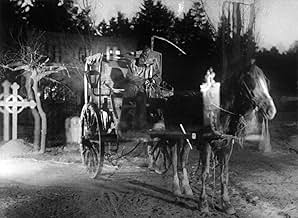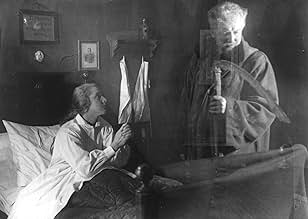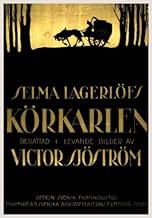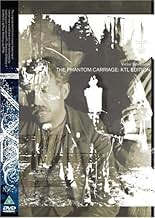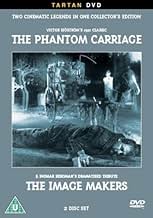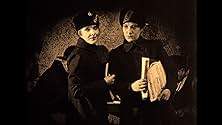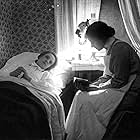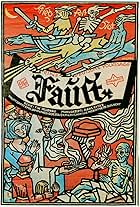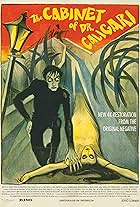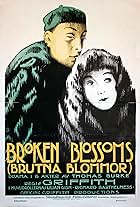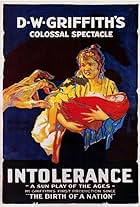On New Year's Eve, the driver of a ghostly carriage forces a drunken man to reflect on his selfish, wasted life.On New Year's Eve, the driver of a ghostly carriage forces a drunken man to reflect on his selfish, wasted life.On New Year's Eve, the driver of a ghostly carriage forces a drunken man to reflect on his selfish, wasted life.
Edvin Adolphson
- Man at the Inn
- (uncredited)
Elof Ahrle
- Young Man
- (uncredited)
Emmy Albiin
- Tuberculosis Patient
- (uncredited)
- Director
- Writers
- All cast & crew
- Production, box office & more at IMDbPro
Storyline
Did you know
- TriviaCharles Chaplin stated this was the best film ever made.
- Quotes
[last lines]
Mrs. Holm: I can't help crying too. I won't be truly happy until all my sorrow is drained.
David Holm: Lord, please let my soul come to maturity before it is reaped.
- Alternate versionsThere is an Italian edition of this film on DVD, distributed by DNA srl, "THE WIND - IL VENTO (1928) + THE PHANTOM CARRIAGE (Il carretto fantasma, 1921)" (2 Films on a single DVD), re-edited with the contribution of film historian Riccardo Cusin. This version is also available for streaming on some platforms.
- ConnectionsFeatured in Ved den danske films vugge (1941)
Featured review
Lord, let my soul come to maturity before it is reaped
"
"Strange...unusual..."someone may think...to begin a review on this film with a prayer, more to say, a prayer not to achieve wisdom or intellect but...maturity - something that has hardly been a theme of many top notch productions - something hardly even mentioned as a human merit in the commercial world - yet, something at the core of this film's message.
In the period of supermen and thrilling actions, viewer's eyes and perceptions are not used to such reflective dimensions. However, it appears that Victor Sjoestrom's masterpiece, based on the 1912 novel THY SOUL SHALL BEAR WITNESS by the Noble Prize winner Selma Lagerlof finds its most profound gist in that. THE PHANTOM CARRIAGE made almost 90 years ago is a milestone in Swedish cinema and a notable film that has overwhelmed eminent people of the 20th century, including Ingmar Bergman. But, I usually ask myself a question, especially before the meditative time of November, what is it that makes such films stand out as masterpieces. Is it the direction, the cinematography, special effects, narrative structure, or perhaps something less common in an ordinary discussion...?
Having watched the restored version with its newly commissioned soundtrack by KTL, I had a feeling that I was watching something unique. Of course, I had heard before how significant it was for the cinema but that did not play a decisive role in my experience. I was mesmerized whilst my own subjective viewing and found this silent pearl captivating. Yes, Sjostrom's film touched me tremendously with its innovative structure of flashbacks (although there are flashbacks within flashbacks, I did not get confused), with its powerful cinematography by Julius Jaenzon, with its flawless direction by the master of Swedish cinema who plays the lead as well. The images that are in this film are really hard to forget, hard to skip. The viewer is, as if, taken to its world, experiences what the characters get through, absorbs oneself to a great extend with what one sees in this silent masterpiece. Everything seems to be balanced and crafted so well, including the movements of the camera, the extensive use of special effects, double exposures in the visualization of the ghost characters who walk in three dimensions, the tension and the performances of the great Swedish cast of the time.
It is truly hard to skip the mesmerizing, symbolic, even ICONIC moments of the movie when the driver of the 'strict master' (Death) arrives at various spots, including the sea (intense visual experience), the room of a rich suicide, the streets as well as the graveyard where David (Victor Sjostrom) is to substitute his pal Georges (Tore Svennberg) on that memorable New Year's Eve. The visual feast finds its climax at the moment when David, having visited the dying Edit (Astrid Holm), the member of the Fralsningsarmen (Salvation Army), arrives finally at his home and sees the drama of his wife and children, the drama caused by his monster-like behavior. The visual moment worth high consideration is when David comes back to his home obscene and drunk, is closed in the kitchen by his wife who is afraid of tuberculosis infection and he brutally takes the axe and breaks through the door. The whole drama becomes visually and mentally so powerful that tears are running on the cheeks of a more delicate viewer. However, the greatest maturity of the film is its content so vividly derived from Selma Lagerlof's novel and so creatively executed in this picture...
There is everything that human heart can experience: love, disappointment, courage, sympathy, fear, bad influence, fights, suffering, loneliness, sorrow, wretchedness, despair, but finally the glory of reconciliation and tears of joy. There are truly different psychological dimensions, or more to say, mental journeys that the director, with the masterful power of the source novel, invites us to experience. There are elements of gloom, the elements of intensive mysticism; there is a redeeming power of prayer for other people (the plot of Edit) and the gist of penance. While the film seems to touch the very heart of Christianity at certain moments, it also appears to evoke thought provoking feelings about what, in fact, is the most important value in life.
The bitter experience of the leading character makes us shocked at first but...in time, indifferent to his feelings. He becomes a villain in our eyes. Although the character of Georges proves to us the consequences of bad influence, we don't see David as a victim (sort of) but as a single human being responsible for himself. We, as viewers, at certain moment, stop feeling empathy with the character but rather concentrate on other people, good people and cry with them. But, at the right moment, we seem to realize his plea to God, his fruitful tears of penance, we seem to forgive him as his wife (Hilga Borgstrom) does forgive him. The human heart appears to shout out from its depths: "Genuine redemptive tears!" What a drama! What a psychological feast! What a movie that evokes such feelings! That is the profoundity of THE PHANTOM CARRIAGE and though that aspect may be considered difficult to capture for some viewers, I think it is an absolute necessity while analyzing this film.
Although the movie has become a source of inspiration for many eminent people of cinema, I think that not all of them understood its gist in the right manner. Enthusiastically speaking, it is another silent film that proves the masterful nature of the early cinema and a film that may be seen from different angles. Nevertheless, there is also a danger that we condense its meaning to a sheer scary movie and look through the terrifying moments ignoring the rest. That would be nothing but an unforgivable conjecture. THE PHANTOM CARRIAGE is a story of a joyful gift, of another chance to become mature, a redemptive chance. Masterpiece, 10/10
"Strange...unusual..."someone may think...to begin a review on this film with a prayer, more to say, a prayer not to achieve wisdom or intellect but...maturity - something that has hardly been a theme of many top notch productions - something hardly even mentioned as a human merit in the commercial world - yet, something at the core of this film's message.
In the period of supermen and thrilling actions, viewer's eyes and perceptions are not used to such reflective dimensions. However, it appears that Victor Sjoestrom's masterpiece, based on the 1912 novel THY SOUL SHALL BEAR WITNESS by the Noble Prize winner Selma Lagerlof finds its most profound gist in that. THE PHANTOM CARRIAGE made almost 90 years ago is a milestone in Swedish cinema and a notable film that has overwhelmed eminent people of the 20th century, including Ingmar Bergman. But, I usually ask myself a question, especially before the meditative time of November, what is it that makes such films stand out as masterpieces. Is it the direction, the cinematography, special effects, narrative structure, or perhaps something less common in an ordinary discussion...?
Having watched the restored version with its newly commissioned soundtrack by KTL, I had a feeling that I was watching something unique. Of course, I had heard before how significant it was for the cinema but that did not play a decisive role in my experience. I was mesmerized whilst my own subjective viewing and found this silent pearl captivating. Yes, Sjostrom's film touched me tremendously with its innovative structure of flashbacks (although there are flashbacks within flashbacks, I did not get confused), with its powerful cinematography by Julius Jaenzon, with its flawless direction by the master of Swedish cinema who plays the lead as well. The images that are in this film are really hard to forget, hard to skip. The viewer is, as if, taken to its world, experiences what the characters get through, absorbs oneself to a great extend with what one sees in this silent masterpiece. Everything seems to be balanced and crafted so well, including the movements of the camera, the extensive use of special effects, double exposures in the visualization of the ghost characters who walk in three dimensions, the tension and the performances of the great Swedish cast of the time.
It is truly hard to skip the mesmerizing, symbolic, even ICONIC moments of the movie when the driver of the 'strict master' (Death) arrives at various spots, including the sea (intense visual experience), the room of a rich suicide, the streets as well as the graveyard where David (Victor Sjostrom) is to substitute his pal Georges (Tore Svennberg) on that memorable New Year's Eve. The visual feast finds its climax at the moment when David, having visited the dying Edit (Astrid Holm), the member of the Fralsningsarmen (Salvation Army), arrives finally at his home and sees the drama of his wife and children, the drama caused by his monster-like behavior. The visual moment worth high consideration is when David comes back to his home obscene and drunk, is closed in the kitchen by his wife who is afraid of tuberculosis infection and he brutally takes the axe and breaks through the door. The whole drama becomes visually and mentally so powerful that tears are running on the cheeks of a more delicate viewer. However, the greatest maturity of the film is its content so vividly derived from Selma Lagerlof's novel and so creatively executed in this picture...
There is everything that human heart can experience: love, disappointment, courage, sympathy, fear, bad influence, fights, suffering, loneliness, sorrow, wretchedness, despair, but finally the glory of reconciliation and tears of joy. There are truly different psychological dimensions, or more to say, mental journeys that the director, with the masterful power of the source novel, invites us to experience. There are elements of gloom, the elements of intensive mysticism; there is a redeeming power of prayer for other people (the plot of Edit) and the gist of penance. While the film seems to touch the very heart of Christianity at certain moments, it also appears to evoke thought provoking feelings about what, in fact, is the most important value in life.
The bitter experience of the leading character makes us shocked at first but...in time, indifferent to his feelings. He becomes a villain in our eyes. Although the character of Georges proves to us the consequences of bad influence, we don't see David as a victim (sort of) but as a single human being responsible for himself. We, as viewers, at certain moment, stop feeling empathy with the character but rather concentrate on other people, good people and cry with them. But, at the right moment, we seem to realize his plea to God, his fruitful tears of penance, we seem to forgive him as his wife (Hilga Borgstrom) does forgive him. The human heart appears to shout out from its depths: "Genuine redemptive tears!" What a drama! What a psychological feast! What a movie that evokes such feelings! That is the profoundity of THE PHANTOM CARRIAGE and though that aspect may be considered difficult to capture for some viewers, I think it is an absolute necessity while analyzing this film.
Although the movie has become a source of inspiration for many eminent people of cinema, I think that not all of them understood its gist in the right manner. Enthusiastically speaking, it is another silent film that proves the masterful nature of the early cinema and a film that may be seen from different angles. Nevertheless, there is also a danger that we condense its meaning to a sheer scary movie and look through the terrifying moments ignoring the rest. That would be nothing but an unforgivable conjecture. THE PHANTOM CARRIAGE is a story of a joyful gift, of another chance to become mature, a redemptive chance. Masterpiece, 10/10
- marcin_kukuczka
- Oct 30, 2010
- Permalink
- How long is The Phantom Carriage?Powered by Alexa
Details
- Runtime1 hour 47 minutes
- Sound mix
- Aspect ratio
- 1.33 : 1
Contribute to this page
Suggest an edit or add missing content

